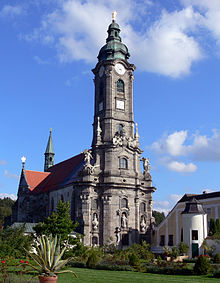Zwettl Abbey
| Zwettl Abbey | |
|---|---|

Zwettl Abbey Church in Zwettl, Austria
|
|
| Basic information | |
| Location | Zwettl, Austria |
| Geographic coordinates | 48°37′01″N 15°12′00″E / 48.616944°N 15.2°ECoordinates: 48°37′01″N 15°12′00″E / 48.616944°N 15.2°E |
| Affiliation | Catholic Church |
| State | Lower Austria |
| Year consecrated | 1138 |
| Leadership | Wolfgang (Peter) Wiedermann |
| Architectural description | |
| Architectural style | Romanesque, Baroque |
| Founder | Hadmar I of Kuenring |
| Completed | 1137 |
Zwettl Abbey (German: Stift Zwettl) is a Cistercian monastery located in Zwettl in Lower Austria, in the Diocese of St. Pölten.
Zwettl Abbey was founded in 1137 by Hadmar I of Kuenring, with Herrmann, a monk of Heiligenkreuz Abbey, as its first abbot (1137–47). It was a daughter house of Heiligenkreuz, of the line of Morimond. The foundation was confirmed by Pope Innocent II (1140) and over the course of time by several other popes and emperors. Several members of the family of the founder were buried here.
The monastery was constructed, as Cistercian houses often were, in a river valley, in this case in a bend of the River Kamp. Extensive buildings were erected, and the church, chapter-room, and dormitory were blessed in 1159, though the entire monastery was not completed until 1218. Zwettl Abbey soon became one of the most important monasteries in the order.
Towards the end of the fourteenth century, the abbey was repeatedly plundered, especially in 1426, when 4,000 Hussites sacked and burned it down. It was rebuilt under Abbot John (1437–51). Near the end of the fifteenth century, over forty monks lived in Zwettl Abbey. Under the Protestant Reformation the community was reduced to six monks and one secular priest. By an imperial rescript the monastery was forced to sell one quarter of its large possessions. It flourished again under Abbot Erasmus (1512-1545) and his successors during the Baroque period, notwithstanding the Thirty Years' War and the Turkish invasion, during which it was saved from destruction by the friendship of the Count of Thurn for Abbot Siegfried.
During the administrations of Abbot Linck (1646–71), author of the Annales Austrio Claravallenses, and Abbot Melchior (1706-1747), who rebuilt a great part of the abbey and enriched it with many precious vessels and vestments, it reached its zenith. Abbot Melchior encouraged study and opened schools of philosophy, theology and so on in the monastery. During the period of Josephinism Abbot Rainer was obliged to resign, to be succeeded by a commendatory abbot (1786), but after 1804 the community was allowed to elect its own abbot. From 1878 the abbey was administered by Abbot Stephen Roessler, the sixty-first from its foundation. Besides him two other noted historians were members of Zwettl during the nineteenth century: Johann von Frast (d. 1850) and Leopold Janauschek, the author of Originum Cisterciensium.
...
Wikipedia
